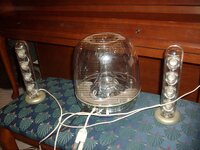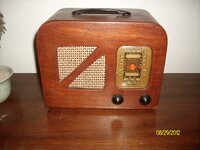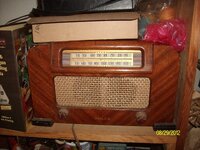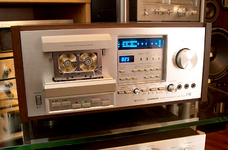Bronze Supporter
- Messages
- 1,291
- Reactions
- 1,448
Not a firearm. A must need on my reel to reel recordings.
I just impulse in this phono preamp and I'll try slapping it to the Vincent SA-T7 tube preamp. I previously tried a tube phono preamp, it sounds too saturated especially in the recording. I tried my old radioshack phono preamp. Its much better on the SA-T7. I guess you cant have tubes too much on certain gears especially the type of music preference. Especially in my recording purpose....
Vista Audio phono-2
High End Phono Preamplifier
Wide adjustment rage suitable for MM and MC cartridges
Direct Coupling
(no capacitors in the signal path)
Class A operation
Bandwidth: 10Hz-40kHz
Input impedance:
Eight presets: 47 ohm – 47 kohm
plus sockets for custom loading resistors
Gain:
Six presets: 40-70dB
Passive RIAA compensation
Active offset Cancellation
Gold plated PCB
Steel case for EMI shielding
Dimensions : 7.25 x 4 x 1.5"
(185 x 100 x 40 mm)
phono-2 is a result of continuous learning which made it possible to meet high level performance of phono-1 and, at the same time, provide more convenient optimization for wide variety of MM and MC cartridges.


The robust steel chassis houses preamplifier circuits and stabilized and filtered power supply. External power supply is a simple line frequency transformer, dislocated to eliminate influence of electromagnetic fields on the sensitive electronics.

Bottom side of phono-2 hosts micro switches which are used to set cartridge loading ("Load"), preamplifier gain ("Gain") and output filtration ("Low-pass filter"). Examples of optimum load and gain settings for various cartridges are listed here. The image below show unit set for 10k load, 55dB gain and 10Hz slow roll-off filter.

phono-1's load and gain optimization phono-2 can have unlimited settings available by removing top cover and accessing terminals for insertion of additional loading resistors and capacitos. Those terminals are marked R11 and R12 for loading resistors and C11 and C12 for loading capacitors.
NOTE: in order to accurately load the cartridge with the additional resistors, all microswitches on teh rear panel should be in the OFF position. When adding loading capacitance, the default capacitance of 50pF should be accounted for: as an example - if the totalloading capacitance of 200pF is desired, additional capacitor needs to have value of 150pF. Capacitors and resistors with lead diameter in the range of 0.025-0.032" (0.6-0.8mm) can be safely inserted. Larger diameter may cause damage to the sockets.

There are six different gain setting possible: 40dB, 50dB, 55dB, 60dB, 65dB and 70dB. The preamplifier gain is set by engaging microswitches as indicated by the printed legend next to the switch. The picture below illustrates gain setting of 65dB.
The phono-2 features an innovative extension of phono-1's active offset cancellation circuit to provide output filtration without adding capacitors into the signal path.There are three available settings:
1) No Filter: this setting leaves only the active offset cancellation engaged and bandwidth of the preamplifier goes down to 2Hz.
2) 10Hz, Slow roll-off filter: with this setting engaged, phono-2's bandwidth goes down to 10Hz, but roll-off starts at about 40Hz. We have found this setting helpful with records equilized by IEC RIAA curve.
3) 10Hz, Fast roll-off filter: our version of subsonic (rumble) filter. Bandwidth goes down to 10Hz, but roll-off starts below 20Hz, thus having no effects on audio frequencies.
The picture bellow illustrates low pass filter setting "10Hz, Slow roll-off"

I just impulse in this phono preamp and I'll try slapping it to the Vincent SA-T7 tube preamp. I previously tried a tube phono preamp, it sounds too saturated especially in the recording. I tried my old radioshack phono preamp. Its much better on the SA-T7. I guess you cant have tubes too much on certain gears especially the type of music preference. Especially in my recording purpose....

Vista Audio phono-2
High End Phono Preamplifier
Wide adjustment rage suitable for MM and MC cartridges
Direct Coupling
(no capacitors in the signal path)
Class A operation
Bandwidth: 10Hz-40kHz
Input impedance:
Eight presets: 47 ohm – 47 kohm
plus sockets for custom loading resistors
Gain:
Six presets: 40-70dB
Passive RIAA compensation
Active offset Cancellation
Gold plated PCB
Steel case for EMI shielding
Dimensions : 7.25 x 4 x 1.5"
(185 x 100 x 40 mm)
phono-2 is a result of continuous learning which made it possible to meet high level performance of phono-1 and, at the same time, provide more convenient optimization for wide variety of MM and MC cartridges.
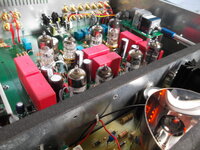
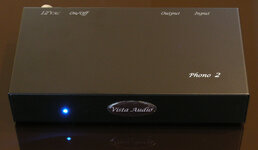
The robust steel chassis houses preamplifier circuits and stabilized and filtered power supply. External power supply is a simple line frequency transformer, dislocated to eliminate influence of electromagnetic fields on the sensitive electronics.

Bottom side of phono-2 hosts micro switches which are used to set cartridge loading ("Load"), preamplifier gain ("Gain") and output filtration ("Low-pass filter"). Examples of optimum load and gain settings for various cartridges are listed here. The image below show unit set for 10k load, 55dB gain and 10Hz slow roll-off filter.

phono-1's load and gain optimization phono-2 can have unlimited settings available by removing top cover and accessing terminals for insertion of additional loading resistors and capacitos. Those terminals are marked R11 and R12 for loading resistors and C11 and C12 for loading capacitors.
NOTE: in order to accurately load the cartridge with the additional resistors, all microswitches on teh rear panel should be in the OFF position. When adding loading capacitance, the default capacitance of 50pF should be accounted for: as an example - if the totalloading capacitance of 200pF is desired, additional capacitor needs to have value of 150pF. Capacitors and resistors with lead diameter in the range of 0.025-0.032" (0.6-0.8mm) can be safely inserted. Larger diameter may cause damage to the sockets.

There are six different gain setting possible: 40dB, 50dB, 55dB, 60dB, 65dB and 70dB. The preamplifier gain is set by engaging microswitches as indicated by the printed legend next to the switch. The picture below illustrates gain setting of 65dB.
The phono-2 features an innovative extension of phono-1's active offset cancellation circuit to provide output filtration without adding capacitors into the signal path.There are three available settings:
1) No Filter: this setting leaves only the active offset cancellation engaged and bandwidth of the preamplifier goes down to 2Hz.
2) 10Hz, Slow roll-off filter: with this setting engaged, phono-2's bandwidth goes down to 10Hz, but roll-off starts at about 40Hz. We have found this setting helpful with records equilized by IEC RIAA curve.
3) 10Hz, Fast roll-off filter: our version of subsonic (rumble) filter. Bandwidth goes down to 10Hz, but roll-off starts below 20Hz, thus having no effects on audio frequencies.
The picture bellow illustrates low pass filter setting "10Hz, Slow roll-off"
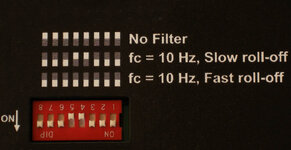
Last Edited:






